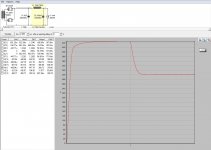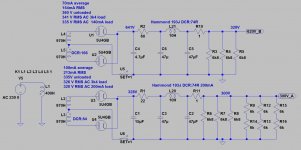Is there any way to test a tube based power supply?
I build one, and the output voltage is bigger than the maximum voltage rated for the output tubes in wich I will use the power supply.
It is a capacitor inductor type.
The power transformer is rated in 320-0-320 200 mA
I am using a GZ 34 diode tube.
I have a 20 mf/ 600 v capacitor and after a 10H 200 mA inductor.
The final voltage should be around 300 volts;
The measured output voltage is around 467 volts.
This voltage reading was obtained without loading the power supply.
Is there any chance the voltage will drop under charge ?
Is there any way or formula to calculate this ?
Is there any way to use a kind off dummy load to simulate the charge
of a amplifier circuit, to test the output voltage ?
I build one, and the output voltage is bigger than the maximum voltage rated for the output tubes in wich I will use the power supply.
It is a capacitor inductor type.
The power transformer is rated in 320-0-320 200 mA
I am using a GZ 34 diode tube.
I have a 20 mf/ 600 v capacitor and after a 10H 200 mA inductor.
The final voltage should be around 300 volts;
The measured output voltage is around 467 volts.
This voltage reading was obtained without loading the power supply.
Is there any chance the voltage will drop under charge ?
Is there any way or formula to calculate this ?
Is there any way to use a kind off dummy load to simulate the charge
of a amplifier circuit, to test the output voltage ?
The final voltage should be around 300 volts; The measured output voltage is around 467 volts.
BTW, there should also be a second, similar capacitor AFTER the inductor.
The output voltage is correct for the transformer that you are using.
If you only want 300V at rated current, you'll have to use an inductor input filter
(which gives the average value of the waveform), instead of a capacitor input filter
(which gives the peak value of the waveform). Or, you could use a different transformer.
Last edited:
There is a second capacitor after the inductor. It is a 500 uf/500 v.
I measured the resistance of the inductor and it is 110 ohms.
I have a capacitor and after it, I have a inductor and after another capacitor.
You are sugesting to change the position of the inductor.
So I have to feed first the inductor and after it, the capacitor ?
I measured the resistance of the inductor and it is 110 ohms.
I have a capacitor and after it, I have a inductor and after another capacitor.
You are sugesting to change the position of the inductor.
So I have to feed first the inductor and after it, the capacitor ?
Why not use PSUD2?
You need to measure power transformer (secunder) DCR, choke DCR.
Quasi choke input (small C, L, C) is tunable with first capacitor.
This simulation use 320V (under max. load, without load this about 335V) 84R DCR transformer (my big 320V/200mA one), Hammond 193J choke (10H, 200mA, 74R DCR).
Without load output voltage about 448V, with 200mA loading only 300V.
You need to measure power transformer (secunder) DCR, choke DCR.
Quasi choke input (small C, L, C) is tunable with first capacitor.
This simulation use 320V (under max. load, without load this about 335V) 84R DCR transformer (my big 320V/200mA one), Hammond 193J choke (10H, 200mA, 74R DCR).
Without load output voltage about 448V, with 200mA loading only 300V.
Attachments
A graph to see what to expect.
I used two 220V/40W lightbulbs in series as a load for testing.
Mona
Tried the light bulbs.
The result was, with no charge 469 volts
With the 2 bulbs in series the voltage droped to 338 volts
And the current is 163 mA.
It is 10 % above the maximum rated voltage for the tubes.
the resistance of the 2 bulbs in serie is 191 ohms.
You suggested the light bulbs. But is there any way to
know the resistance that the power supply " see".
The amplifiers use 2 el 84 in paralel and a SE output transformer
rated in 3K.
I tested my HT PSUs with exact loads.
I have a lot of 50W wirewound aluminium housed resistors (Arcol, Dale etc.) and large heatsinks. Using parallel and series resistors proper load can be making.
How did you setup/calculate the coupled inductors to get the desired voltage of transformer?
Ive been struggling with this in LTSpice.
Can you attach the asc file so I can study and experiment your results?
I tested my HT PSUs with exact loads.
I have a lot of 50W wirewound aluminium housed resistors (Arcol, Dale etc.) and large heatsinks. Using parallel and series resistors proper load can be making.
Understand how to make the load.
But, how to know how much load i will have in the amp circuit.
Tube amplifier output transformers are 3000 Kohms.
Dc resistance is 185 ohms
Can you explain how I can get a number of how many ohms of load I have
in the circuit ?
Empirical method. 🙂How did you setup/calculate the coupled inductors to get the desired voltage of transformer?
Attachments
- Status
- Not open for further replies.
- Home
- Amplifiers
- Power Supplies
- How to test a power supply


